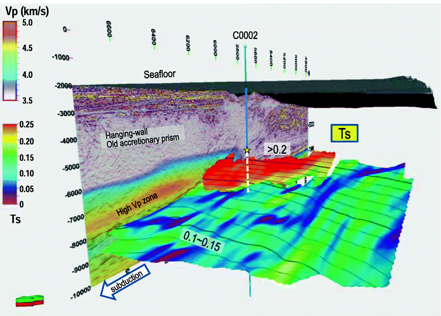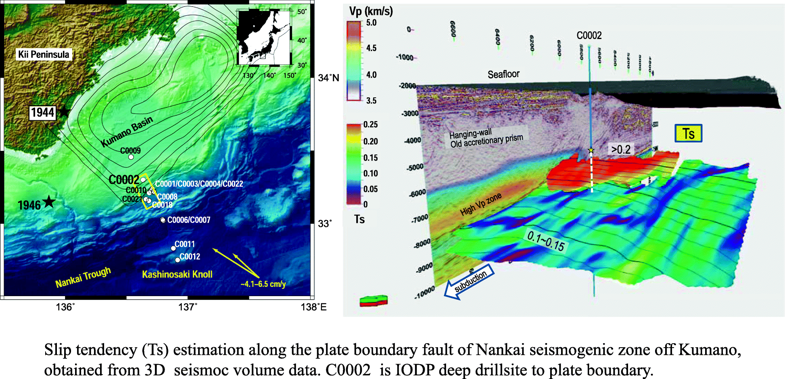Masataka Kinoshita, Kazuya Shiraishi, Evi Demetriou, Yoshitaka Hashimoto and Weiren Lin
Progress in Earth and Planetary Science, 6:7, 2019
https://doi.org/10.1186/s40645-018-0253-y
We assess the dependence of megathrust geometry near the updip edge of the Nankai seismogenic zone according to the slip tendency of the megathrust based on a reprocessed 3D PSDM seismic volume image and International Ocean Discovery Program (IODP) NanTroSEIZE drilling data off the coast of the Kii Peninsula, central Japan. The plate boundary fault surface is manually picked from the 3D seismic volume and is divided into three groups: low dip (10°–15°) trending NW to N in the NE region, intermediate dip (~ 25°) trending north in the western region, and high dip (30°–40°) trending NW in the SE corner. We then calculate the overburden (Sv) by converting the modeled 3D velocity to bulk density. Here, Sv ranges from 100 MPa near the SW edge to 160 MPa on the NE corner. In order to derive horizontal principal stresses (SH and Sh) and the pore fluid pressure (Pp), we assign the ratio of horizontal-to-vertical principal stresses, r (= SH/Sv), and the ratio of pore fluid pressure-to-vertical stress, λ (= Pp/Sv) based on IODP drilling data. The directions of SH and the slip on the fault are set parallel to the plate convergence vector (N55W). Assuming a triaxial condition (SH > Sh = Sv), the slip tendency (Ts) can be calculated from the dip angle and dip azimuth of the fault surface, r, and λ. We found that Ts is sensitive to the variation in fault geometry. For r = 1.2 and λ = 0.7 (normalized pore pressure ratio λ* = 0.25), Ts is low (~ 0.1) in the low-angle dip region and higher (> 0.2) in the high-angle dip region. This suggests that the high-angle fault is optimally oriented under this condition. Low Ts in the low-angle dip region would correspond to a weaker region due to a low frictional strength, assuming that the fault surface should slip simultaneously. Using the high pore pressure ratio (λ* ~ 0.85) beneath the fault zone, the fault beneath IODP Site C0002 is very close to failure if r > 1.2.



